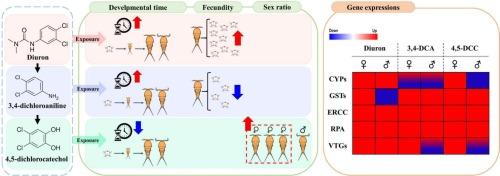迪乌隆转化化学物质对朝鲜虎桡足动物生活史性状的影响
IF 4.9
3区 环境科学与生态学
Q1 ENVIRONMENTAL SCIENCES
引用次数: 0
摘要
Diuron通常用作防污涂料中的增强型杀菌剂,以防止水生生物附着在船体上。在好氧条件下,细菌可将diuron代谢为3,4-二氯苯胺和4,5-二氯儿茶酚,可能对水生生物产生不良影响。我们研究了这三种化学物质对海洋桡足动物朝鲜虎的急性和慢性影响。在急性毒性试验中,diuron是三种化学物质中毒性最大的。在慢性毒性试验中,diuron和3,4- dca增加了发育时间,但4,5- dcc减少了发育时间。diuron增加了繁殖力,3,4- dca降低了繁殖力。暴露于4,5- dcc导致性别比例偏向女性。暴露后解毒、抗氧化和dna修复基因的表达因化学物质和性别而异。上述结果提示,除迪乌隆外,其分解化学物质也可能对海洋桡足类动物产生影响,应对增强型杀菌剂的分解产物进行综合评价,对可分解有机污染物进行环境毒性评价。本文章由计算机程序翻译,如有差异,请以英文原文为准。

Effects of diuron transformed chemicals on life history traits of the copepod Tigriopus koreanus
Diuron is commonly used as a booster biocide in antifouling paints to prevent adherence of aquatic organisms to the hulls of ships. Under aerobic conditions, bacteria can metabolize diuron to 3,4-dichloroaniline and 4,5-dichlorocatechol, which may induce adverse effects on aquatic organisms. We investigated the acute and chronic effects of these three chemicals on the marine copepod Tigriopus koreanus. In the acute toxicity test, diuron was the most toxic of the three chemicals. In the chronic toxicity test, developmental time was increased by diuron and 3,4-DCA, but was reduced by 4,5-DCC. Fecundity was increased by diuron but reduced by 3,4-DCA. Exposure to 4,5-DCC resulted in a female-biased sex ratio. Post-exposure expression of detoxification, antioxidant, and DNA-repair genes differed depending on the chemical and sex. These results suggest that not only diuron but also its decomposed chemicals may affect marine copepods, and decomposed products of booster biocides should be evaluated for a comprehensive environmental toxicity assessment of decomposable organic pollutants.
求助全文
通过发布文献求助,成功后即可免费获取论文全文。
去求助
来源期刊

Marine pollution bulletin
环境科学-海洋与淡水生物学
CiteScore
10.20
自引率
15.50%
发文量
1077
审稿时长
68 days
期刊介绍:
Marine Pollution Bulletin is concerned with the rational use of maritime and marine resources in estuaries, the seas and oceans, as well as with documenting marine pollution and introducing new forms of measurement and analysis. A wide range of topics are discussed as news, comment, reviews and research reports, not only on effluent disposal and pollution control, but also on the management, economic aspects and protection of the marine environment in general.
 求助内容:
求助内容: 应助结果提醒方式:
应助结果提醒方式:


